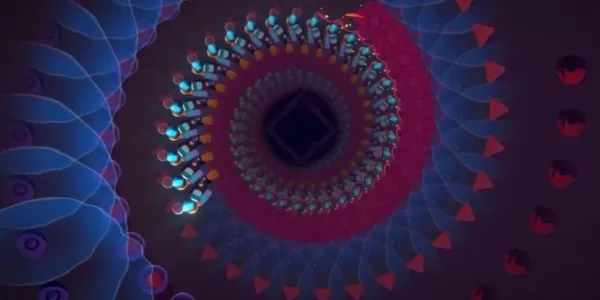Nvidia's DLSS, or Deep Learning Super Sampling, has revolutionized PC gaming since its introduction in 2019. This technology not only enhances performance but also adds significant value to Nvidia's RTX graphics cards, especially for gamers playing titles that support DLSS. Over the years, DLSS has evolved through multiple updates, improving its functionality and distinguishing features across different RTX generations. In this comprehensive guide, we'll explore what DLSS is, how it functions, its generational differences, and its importance—even if you're not currently using an Nvidia graphics card.
Additional contributions by Matthew S. Smith.
What Is DLSS?
Nvidia DLSS, or Deep Learning Super Sampling, is Nvidia's proprietary technology designed to boost game performance and image quality. The "Super Sampling" aspect refers to its ability to upscale games to higher resolutions using a neural network trained on extensive gameplay data. This method allows for higher resolutions without the usual performance hit of manually setting a higher resolution in-game.
Initially focused on upscaling, DLSS now encompasses several systems that enhance image quality beyond mere resolution increases. These include:
- DLSS Ray Reconstruction: Enhances lighting and shadow quality using AI.
- DLSS Frame Generation and Multi Frame Generation: Use AI to insert additional frames, significantly boosting frame rates.
- DLAA (Deep Learning Anti-Aliasing): Applies AI-enhanced anti-aliasing for superior graphics compared to native resolution.
The most recognized feature of DLSS is Super Resolution, particularly beneficial when combined with ray tracing. In supported games, you can choose from various DLSS modes like Ultra Performance, Performance, Balanced, and Quality. For example, in Cyberpunk 2077, selecting 4K resolution with DLSS Quality mode means the game renders at 1440p, which is easier to run, and DLSS upscales it to 4K, resulting in a higher frame rate.
DLSS's neural rendering differs significantly from older techniques like checkerboard rendering, adding details not visible at native resolution and preserving details lost in other upscaling methods. However, it can introduce artifacts like "bubbling" shadows or flickering lines, though these have been considerably improved, especially in DLSS 4.
The Generational Leap: DLSS 3 to DLSS 4
With the RTX 50-series, Nvidia introduced DLSS 4, which revolutionizes the AI model used, enhancing its quality and capabilities. DLSS 3 and DLSS 3.5 utilized a Convolutional Neural Network (CNN), trained on vast video game data to analyze scenes and spatial relationships. However, DLSS 4 shifts to a more advanced Transformer model, or TNN, capable of processing twice as many parameters and understanding scenes more deeply.
This upgrade significantly improves DLSS Super Sampling and DLSS Ray Reconstruction, retaining finer details and reducing artifacts like bubbling shadows and flickering lines. The TNN model also enhances frame generation, allowing DLSS 4 to insert four artificial frames per rendered frame through DLSS Multi Frame Generation, potentially quadrupling frame rates. Nvidia's Reflex 2.0 complements this by minimizing input latency.
While DLSS 4 offers impressive enhancements, it's not without its challenges. Frame generation can sometimes result in minor ghosting behind moving objects, especially at higher settings. Nvidia smartly allows users to adjust frame generation to match their monitor's refresh rate, preventing issues like screen tearing.
Even without an RTX 50-series card, users can benefit from the new Transformer model for DLSS Super Resolution and DLSS Ray Reconstruction using the Nvidia App, which also supports DLSS Ultra Performance mode and DLAA if not available in-game.
Why Does DLSS Matter for Gaming?
DLSS is a pivotal technology for PC gaming, particularly for those with mid-range or lower-performance Nvidia GPUs. It enables higher graphics settings and resolutions, extending the lifespan of your graphics card. As GPU prices continue to rise, DLSS offers a cost-effective solution by maintaining playable frame rates through adjustable settings.
DLSS has not only benefited Nvidia users but has also spurred competition, with AMD and Intel introducing their own upscaling technologies: AMD FidelityFX Super Resolution (FSR) and Intel Xe Super Sampling (XeSS). While Nvidia's DLSS sets a high standard in image quality and frame generation, AMD and Intel's solutions provide viable alternatives, making high-performance gaming more accessible across different hardware.
Nvidia DLSS vs. AMD FSR vs. Intel XeSS
DLSS faces competition from AMD's FidelityFX Super Resolution (FSR) and Intel's Xe Super Sampling (XeSS). DLSS 4's advanced AI model gives Nvidia a significant edge in image quality and frame generation, though all three technologies offer performance improvements. DLSS's superior image consistency and fewer artifacts make it stand out, although it's exclusive to Nvidia GPUs and requires game developer implementation.
Conclusion
Nvidia DLSS continues to evolve, pushing the boundaries of what's possible in PC gaming. Its ongoing improvements demonstrate Nvidia's commitment to enhancing this technology. While DLSS isn't perfect, its impact on gaming performance and graphics quality is undeniable, extending the life of your GPU.
However, DLSS is no longer the only player in the field, with AMD and Intel offering competitive alternatives. When choosing a GPU, it's crucial to consider the balance between cost, features, and the games you play to determine the best value for your needs.
 Home
Home  Navigation
Navigation






 Latest Articles
Latest Articles










 Latest Games
Latest Games




![Chubby Story [v1.4.2] (Localizations)](https://imgs.xddxz.com/uploads/85/1719638042667f981a5e9f8.jpg)

![Zia – New Version 0.4 [Studio Zia]](https://imgs.xddxz.com/uploads/47/1719569268667e8b74e6004.jpg)




